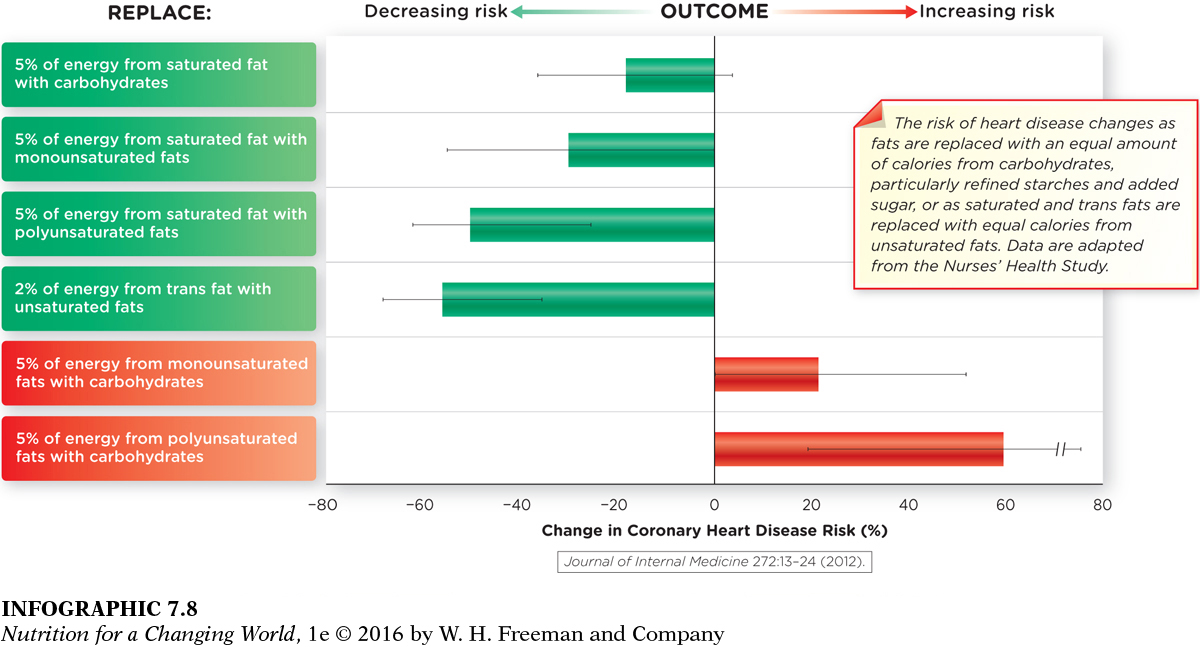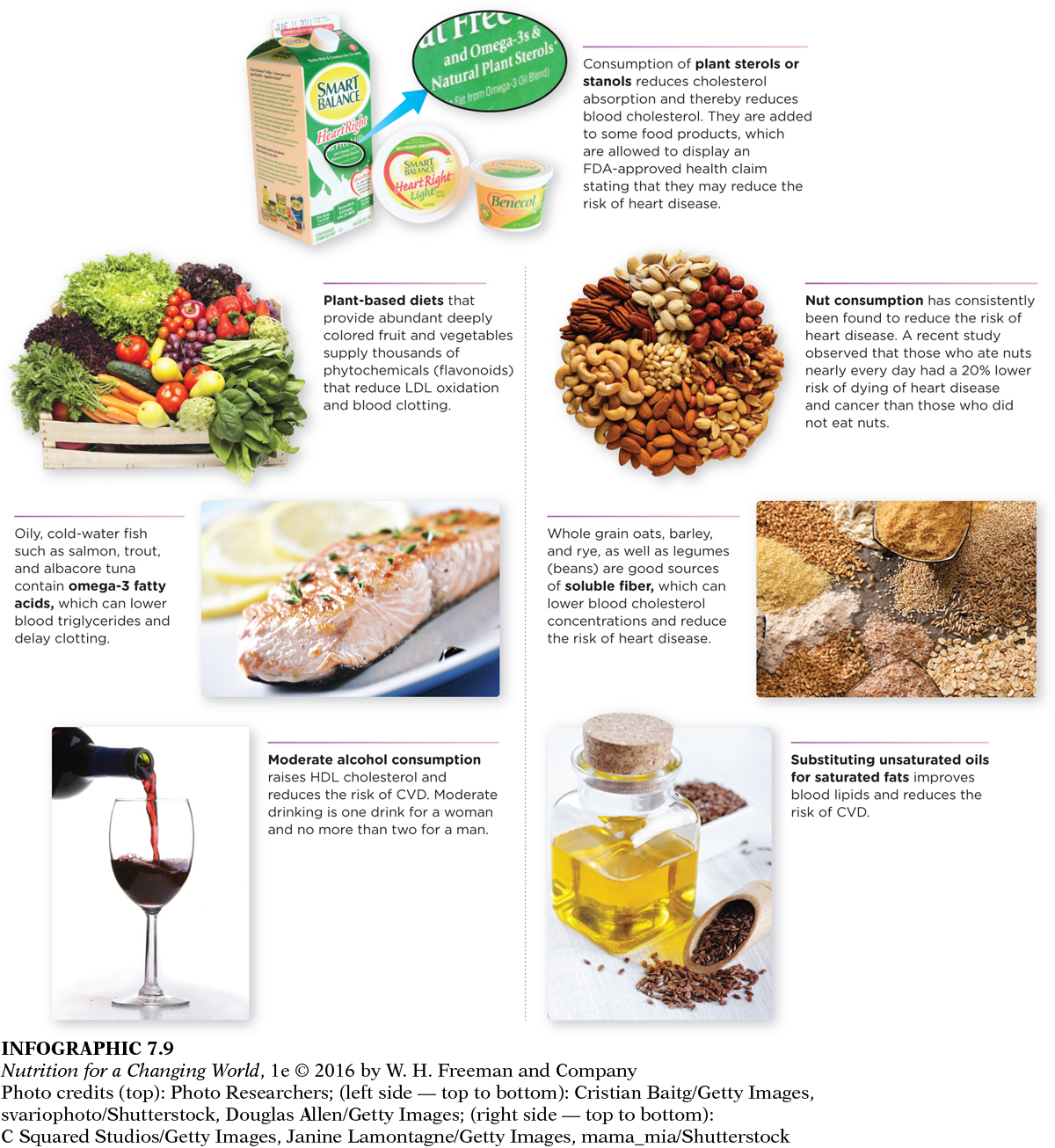A HEART-PROTECTIVE DIET
Although saturated fatty acids do, indeed, have the potential to raise total and LDL cholesterol levels, an important factor to consider is what people who cut back on saturated fatty acids eat instead. For instance, if people replace high-fat foods with lower-fat options that are high in carbohydrates, particularly refined starches, added sugar, and potatoes (which happens frequently), then they aren’t likely going to see health benefits. Low-fat diets high in carbohydrates, particularly when low in fiber and high in sugar, actually increase triglyceride levels in the blood. And some recent analyses even suggest that some sources of saturated fatty acids, such as those in dairy products and coconut oil, don’t necessarily negatively affect blood lipids levels and increase the risk of CVD. However, based on current evidence, the best overall strategy is to replace saturated fatty acids with unsaturated ones, and to emphasize vegetables, fruits, and whole grains in the diet. (INFOGRAPHIC 7.8)
INFOGRAPHIC 7.8 Dietary Fat Replacement and Heart Disease Risk

Question
7.7
 What is the most effective dietary substitution that we can make to reduce the risk of coronary heart disease?
What is the most effective dietary substitution that we can make to reduce the risk of coronary heart disease?
Replacing 2% of energy from trans fat with unsaturated fat is the most effective dietary substitution we can make to reduce risk of coronary heart disease.
The Dietary Guidelines for Americans recommend limiting overall saturated fat intake to 10% or less of total daily calories. In contrast to earlier editions, the 2015 Guidelines do not establish specific limits for dietary cholesterol, but qualify that eating as little as possible is advisable within a healthy eating pattern (see Chapter 2). For those with increased risk for heart disease and high blood cholesterol levels, recommendations from the National Cholesterol Education Program (NCEP) of the National Institutes of Health are to keep calories from saturated fat under 7%. NCEP created the Therapeutic Lifestyle Changes (TLC) program, which incorporates diet, physical activity, and weight management to lower blood cholesterol levels and reduce the risk of heart disease. Also endorsed by the American Heart Association, the TLC dietary component focuses on lowering saturated fat and dietary cholesterol along with other heart-healthy strategies, such as eating foods that have added plant sterols and stanols and contain sufficient soluble fiber.
When the Bogalusa Heart Study began in 1972, Berenson and his colleagues were interested in identifying risk factors that contribute to heart disease in childhood, in part because other studies had identified risk factors in adulthood. The Nurses’ Health Study, for instance, has followed more than 120,000 women since 1976, looking for links between their diets and lifestyles and their risks of various diseases. When the researchers examined women’s fat intake, they found that women who ate the most polyunsaturated fatty acids were the least likely to develop heart disease.
Research has also found that monounsaturated fatty acids can improve blood lipid profiles, including raising HDL cholesterol and lowering overall triglyceride levels, which may reduce the risk of heart disease. But you can get too much of a good thing—there is no consistent rationale or recommendation for the specific amount of monounsaturated fatty acids we should obtain from our diets, but the American Heart Association suggests people get no more than 25% to 35% of their total calories from fat, most of which should come from unsaturated fatty acids, and that saturated fat not exceed 7% of total calories.
Furthermore, different unsaturated fats have different effects on the body, as well. Omega-6 polyunsaturated fatty acids, for instance, appear to improve blood lipid profiles, especially when they take the place of saturated fatty acids, reducing the risk of heart disease. The American Heart Association suggests this type of fat should make up no less than 5% to 10% of our total calories, given that they appear to reduce inflammation, a culprit in the initiation of plaque development.
Some research suggests omega-3 fatty acids may hold particular health benefits, but the picture remains somewhat unclear—low levels of the omega-3 docosahexaenoic acid (DHA) in the diet may increase the risk of Alzheimer disease and other forms of dementia, but it’s not known whether DHA supplements hold any benefits. However, increasing the intake of DHA and EPA (eicosapentaenoic acid, another omega-3 fatty acid) will generally lower the level of circulating triglycerides.
Everyone’s diet contains a ratio of omega-6 and omega-3 fatty acids—meaning the amount of each, relative to each other. The lower the ratio, the better (such as 5:1 or 4:1), but that’s difficult to achieve, given that omega-6-rich foods are much more common in the U.S. diet. Most Americans, and others who follow a Western diet, eat much more omega-6 fatty acids than omega-3 fatty acids, with a typical ratio of 10:1.
But for some dietary fats, the effect on health is clear—trans fatty acids, for instance, help lengthen a food’s shelf life and are therefore often found in many commercial cakes, cookies, pies, and pastries. But these fats also raise LDL and lower HDL, along with raising total cholesterol levels. And the more trans fatty acids you eat, the higher your risk—even just a 2% increase in calories from trans fats can boost your risk of cardiovascular problems by 23%. In the Nurses’ Health Study, women who ate diets high in trans fats had a significantly higher risk of heart disease.
Since trans fats are nearly impossible to avoid completely (they are naturally present in dairy and meat products), the American Heart Association recommends limiting them to less than 1% of your total calorie intake. But that’s a tough goal to meet, since many hydrogenated or partially hydrogenated oils and food products that include them contain small amounts of trans fat.
One way to monitor your intake is by reading food labels, which are now required to list trans fat content. Still, products with less than 0.5 gram of trans fats are allowed to claim they contain 0 grams trans fat—and eating several of those throughout the day could cause people to unknowingly exceed the maximum recommendation set by the American Heart Association. Still, the amount of trans fats Americans eat has dropped significantly since these labeling laws took effect, likely due to a combination of consumers’ increased awareness and manufacturers trying to lower the amount of trans fats present in foods, since it must now be declared. The FDA has also issued a preliminary determination that partially hydrogenated oils are no longer “generally recognized as safe.” Recall from Chapter 6 that the manufacturing practice of partial hydrogenation can chemically modify a fat so that it takes on a trans formation.
But people don’t make a meal of trans fats, saturated fats, or omega-3 and omega-6 fatty acids; instead, they think in terms of food. Some foods are naturally rich in heart-healthy fats, such as nuts. Unsalted peanuts and some tree nuts, specifically walnuts, almonds, pecans, and pistachios, are particularly beneficial, and eating at least five ounces per week (roughly 900 calories) is consistently associated with a lower risk of heart disease. As long as you don’t simply add nuts to the foods you’re already eating—thereby increasing your fat and calorie intake—they are a good component of a healthy diet, contributing unsaturated fatty acids, fiber, protein, folate, minerals, antioxidants, and phytochemicals. (INFOGRAPHIC 7.9)
INFOGRAPHIC 7.9 Diet Strategies to Reduce the Risk of Heart Disease Select foods that can reduce your risk of heart disease.

Question
7.8
 What two types of foods have been shown to reduce blood clotting? The frequent consumption of what type of food has recently been shown to reduce the risk of death from both heart disease and cancer?
What two types of foods have been shown to reduce blood clotting? The frequent consumption of what type of food has recently been shown to reduce the risk of death from both heart disease and cancer?
The consumption of plant-based diets and cold-water fish reduces blood clotting. Nut consumption reduces risk of death from heart disease and cancer.
Another great food source of healthy fats is fish, especially oily, cold-water fish such as anchovies, sardines, trout, albacore tuna, and salmon. The American Heart Association recommends at least two weekly servings of these fish, which provide omega-3 fatty acids, protein, and other key nutrients. Research shows fish oil—rich in these healthy fats—lowers triglyceride levels, blood pressure, and heart rate, so it’s not surprising that eating fish regularly is associated with a lower risk of CVD. Many companies now sell fish oil as a supplement, but it’s not yet clear whether these supplements yield the same health benefits as whole fish. Since some types of fish have high levels of mercury and other environmental pollutants, it’s important to limit consumption of some types, such as shark, swordfish, king mackerel, and tilefish, which contain high levels of mercury.

 What is the most effective dietary substitution that we can make to reduce the risk of coronary heart disease?
What is the most effective dietary substitution that we can make to reduce the risk of coronary heart disease?
 What two types of foods have been shown to reduce blood clotting? The frequent consumption of what type of food has recently been shown to reduce the risk of death from both heart disease and cancer?
What two types of foods have been shown to reduce blood clotting? The frequent consumption of what type of food has recently been shown to reduce the risk of death from both heart disease and cancer?